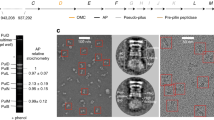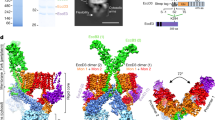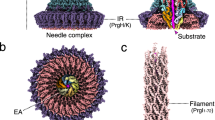Abstract
The type III secretion system (T3SS) is a macromolecular 'injectisome' that allows bacterial pathogens to transport virulence proteins into the eukaryotic host cell. This macromolecular complex is composed of connected ring-like structures that span both bacterial membranes. The crystal structures of the periplasmic domain of the outer membrane secretin EscC and the inner membrane protein PrgH reveal the conservation of a modular fold among the three proteins that form the outer membrane and inner membrane rings of the T3SS. This leads to the hypothesis that this conserved fold provides a common ring-building motif that allows for the assembly of the variably sized outer membrane and inner membrane rings characteristic of the T3SS. Using an integrated structural and experimental approach, we generated ring models for the periplasmic domain of EscC and placed them in the context of the assembled T3SS, providing evidence for direct interaction between the outer membrane and inner membrane ring components and an unprecedented span of the outer membrane secretin.
This is a preview of subscription content, access via your institution
Access options
Subscribe to this journal
Receive 12 print issues and online access
$189.00 per year
only $15.75 per issue
Buy this article
- Purchase on Springer Link
- Instant access to full article PDF
Prices may be subject to local taxes which are calculated during checkout






Similar content being viewed by others
References
Ghosh, P. Process of protein transport by the type III secretion system. Microbiol. Mol. Biol. Rev 68, 771–795 (2004).
Kimbrough, T.G. & Miller, S.I. Contribution of Salmonella typhimurium type III secretion components to needle complex formation. Proc. Natl. Acad. Sci. USA 97, 11008–11013 (2000).
Sukhan, A., Kubori, T., Wilson, J. & Galan, J.E. Genetic analysis of assembly of the Salmonella enterica serovar Typhimurium type III secretion-associated needle complex. J. Bacteriol. 183, 1159–1167 (2001).
Kimbrough, T.G. & Miller, S.I. Assembly of the type III secretion needle complex of Salmonella typhimurium. Microbes Infect. 4, 75–82 (2002).
Marlovits, T.C. et al. Structural insights into the assembly of the type III secretion needle complex. Science 306, 1040–1042 (2004).
Blocker, A. et al. Structure and composition of the Shigella flexneri “needle complex”, a part of its type III secreton. Mol. Microbiol. 39, 652–663 (2001).
Ogino, T. et al. Assembly of the type III secretion apparatus of enteropathogenic Escherichia coli. J. Bacteriol. 188, 2801–2811 (2006).
Yip, C.K. et al. Structural characterization of the molecular platform for type III secretion system assembly. Nature 435, 702–707 (2005).
André, I., Bradley, P., Wang, C. & Baker, D. Prediction of the structure of symmetrical protein assemblies. Proc. Natl. Acad. Sci. USA 104, 17656–17661 (2007).
Sani, M et al. Structural organization of the needle complex of the type III secretion apparatus of Shigella flexneri. Micron. 38, 291–301 (2007).
Pallen, M.J., Beatson, S.A. & Bailey, C.M. Bioinformatics analysis of the locus for enterocyte effacement provides novel insights into type-III secretion. BMC Microbiol. 5, 9–21 (2005).
Genin, S. & Boucher, C.A. A superfamily of proteins involved in different secretion pathways in Gram-negative bacteria: modular structure and specificity of the N-terminal domain. Mol. Gen. Genet. 243, 112–118 (1994).
Crago, A.M & Koronakis, V . Salmonella InvG forms a ring-like multimer that requires the InvH lipoprotein for outer membrane localization. Mol. Microbiol. 30, 47–56 (1998).
Burghout, P. et al. Structure and electrophysiological properties of the YscC secretin from the type III secretion system of Yersinia enterocolitica. J. Bacteriol. 186, 4645–4654 (2004).
Chami, M. et al. Structural insights into the secretin PulD and its trypsin-resistant core. J. Biol. Chem. 280, 37732–37741 (2005).
Collins, R.F. et al. Structure of the Neisseria meningitidis outer membrane PilQ secretin complex at 12 Å resolution. J. Biol. Chem. 279, 39750–39756 (2004).
Bitter, W. Secretins of Pseudomonas aeruginosa: large holes in the outer membrane. Arch. Microbiol. 179, 307–314 (2003).
Opalka, N. et al. Structure of the filamentous phage pIV multimer by cryo-electron microscopy. J. Mol. Biol. 325, 461–470 (2003).
Brok, R. et al. The C-terminal domain of the Pseudomonas secretin XcpQ forms oligomeric rings with pore activity. J. Mol. Biol. 294, 1169–1179 (1999).
Chacón, P. & Wriggers, W. Multi-resolution contour-based fitting of macromolecular structures. J. Mol. Biol. 317, 375–384 (2002).
Marlovits, T.C. et al. Assembly of the inner rod determines needle length in the type III secretion injectisome. Nature 441, 637–640 (2006).
Dong, C. et al. Wza the translocon for E. coli capsular polysaccharides defines a new class of membrane protein. Nature 444, 226–229 (2006).
Guilvout, I. et al. Bacterial outer membrane secretin PulD assembles and inserts into the inner membrane in the absence of its pilotin. EMBO J. 25, 5241–5249 (2006).
Krehenbrink, M. et al. Artificial binding proteins (Affitins) as probes for conformational changes in secretin PulD. J. Mol. Biol. 383, 1058–1068 (2008).
Korotkov, K.V., Pardon, E., Steyaert, J. & Hol, W.G. Crystal structure of the N-terminal domain of the secretin GspD from ETEC determined with the assistance of a nanobody. Structure 17, 255–265 (2009).
Rohl, C.A., Strauss, C.E., Misura, K.M. & Baker, D. Protein structure prediction using Rosetta. Methods Enzymol. 383, 66–93 (2004).
Kuhlman, B. & Baker, D. Native protein sequences are close to optimal for their structures. Proc. Natl. Acad. Sci. USA 97, 10383–10388 (2000).
Qian, B. et al. High-resolution structure prediction and the crystallographic phase problem. Nature 450, 259–264 (2007).
Chenna, R. et al. Multiple sequence alignment with the Clustal series of programs. Nucleic Acids Res. 31, 3497–3500 (2003).
Pettersen, E.F. et al. UCSF Chimera—a visualization system for exploratory research and analysis. J. Comput. Chem. 25, 1605–1612 (2004).
Ohi, M., Li, Y., Cheng, Y. & Walz, T. Negative stain and image classification – powerful tools in modern electron microscopy. Biol. Proced. Online 6, 23–34 (2004).
Ludtke, S.J., Baldwin, P.R. & Chiu, W. EMAN: semiautomated software for high-resolution single-particle reconstructions. J. Struct. Biol. 128, 82–97 (1999).
Frank, J. et al. SPIDER and WEB: processing and visualization of images in 3D electron microscopy and related fields. J. Struct. Biol. 116, 190–199 (1996).
Deng, W. et al. Dissecting virulence: systematic and functional analyses of a pathogenicity island. Proc. Natl. Acad. Sci. USA 101, 3597–3602 (2004).
Datsenko, K.A. & Wanner, B.L. One-step inactivation of chromosomal genes in Escherichia coli K-12 using PCR products. Proc. Natl. Acad. Sci. USA 97, 6640–6645 (2000).
Pegues, D.A., Hantman, M.J., Behlau, I. & Miller, S.I. PhoP/PhoQ transcriptional repression of Salmonella typhimurium invasion genes: evidence for a role in protein secretion. Mol. Microbiol. 17, 169–181 (1995).
Acknowledgements
We thank the staff at the Advanced Light Source beamlines 8.2.2 and 8.3.1 for data collection, time and assistance. C.K.Y. thanks the Natural Science and Engineering Research Council of Canada and the Michael Smith Foundation for Health Research (MSFHR). I.A. is supported by the Knut and Alice Wallenberg foundation. S.S. thanks the Natural Sciences and Engineering Research Council of Canada for postdoctoral funding. N.C.J.S. and B.B.F. thank the Howard Hughes International Scholar program and the Canadian Institutes of Health Research (CIHR) for funding. N.C.J.S. also thanks the MSFHR and Canadian Foundation for Innovation (CFI) for infrastructure funding support. This work was supported by the US National Institutes of Health (NIH) grant P20 GM076222 to D.B. and by NIH grants U54 AI05741 and RO1 AI030479 to S.I.M. We thank T. Walz (Harvard Medical School) for providing resources for the EM measurements, E.E. Galyov (University of Leicester) for providing the SipA, SipB and SipC antibodies and V. Koronakis (University of Cambridge) for providing the InvG antibody. We thank H. Felise, S. Schafer and D. Goodlett for technical advice and assistance.
Author information
Authors and Affiliations
Contributions
C.K.Y., M.V. and A.C.Y. cloned, purified and crystallized the EscC and PrgH constructs, and C.K.Y. determined the crystal structures; molecular modeling was carried out by I.A., and the models were analyzed, interpreted and docked into the EM maps by T.S. and I.A; S.S. did the biochemical characterization in S. typhimurium, and W.D. performed the experiments in EPEC; T.S. established the purification protocol for InvG; T.S. and N.C.J.S. wrote the paper; I.A. prepared Figure 5 and the computational methods; S.S. prepared Figure 4c and Supplementary Figure 3; W.D. prepared Figure 4b and Supplementary Figure 4; all authors discussed the results and commented on the manuscript; D.B. supervised all computational analysis; S.I.M. and B.B.F. provided resources for the biochemical characterizations in S. typhimurium and EPEC, respectively; N.C.J.S. provided resources for all data other than Figures 4b,c and 5 and Supplementary Figures 3 and 4.
Corresponding author
Supplementary information
Supplementary Text and Figures
Supplementary Figures 1–9 and Supplementary Methods (PDF 1093 kb)
Rights and permissions
About this article
Cite this article
Spreter, T., Yip, C., Sanowar, S. et al. A conserved structural motif mediates formation of the periplasmic rings in the type III secretion system. Nat Struct Mol Biol 16, 468–476 (2009). https://doi.org/10.1038/nsmb.1603
Received:
Accepted:
Published:
Issue Date:
DOI: https://doi.org/10.1038/nsmb.1603
This article is cited by
-
Delivering the pain: an overview of the type III secretion system with special consideration for aquatic pathogens
Veterinary Research (2021)
-
Substrate-engaged type III secretion system structures reveal gating mechanism for unfolded protein translocation
Nature Communications (2021)
-
Type three secretion system in Salmonella Typhimurium: the key to infection
Genes & Genomics (2020)
-
Cryo-EM analysis of the T3S injectisome reveals the structure of the needle and open secretin
Nature Communications (2018)
-
A coevolution-guided model for the rotor of the bacterial flagellar motor
Scientific Reports (2018)



